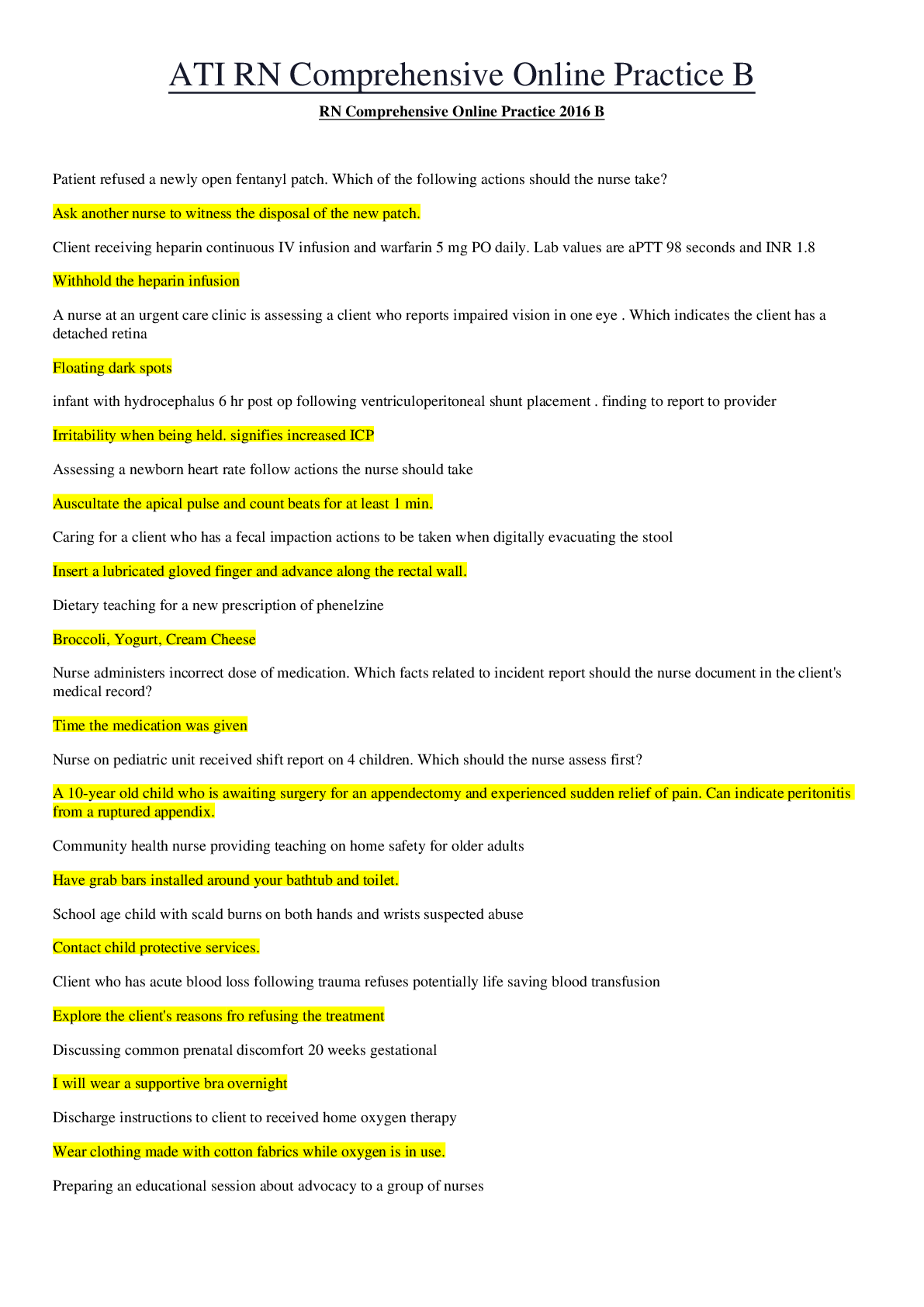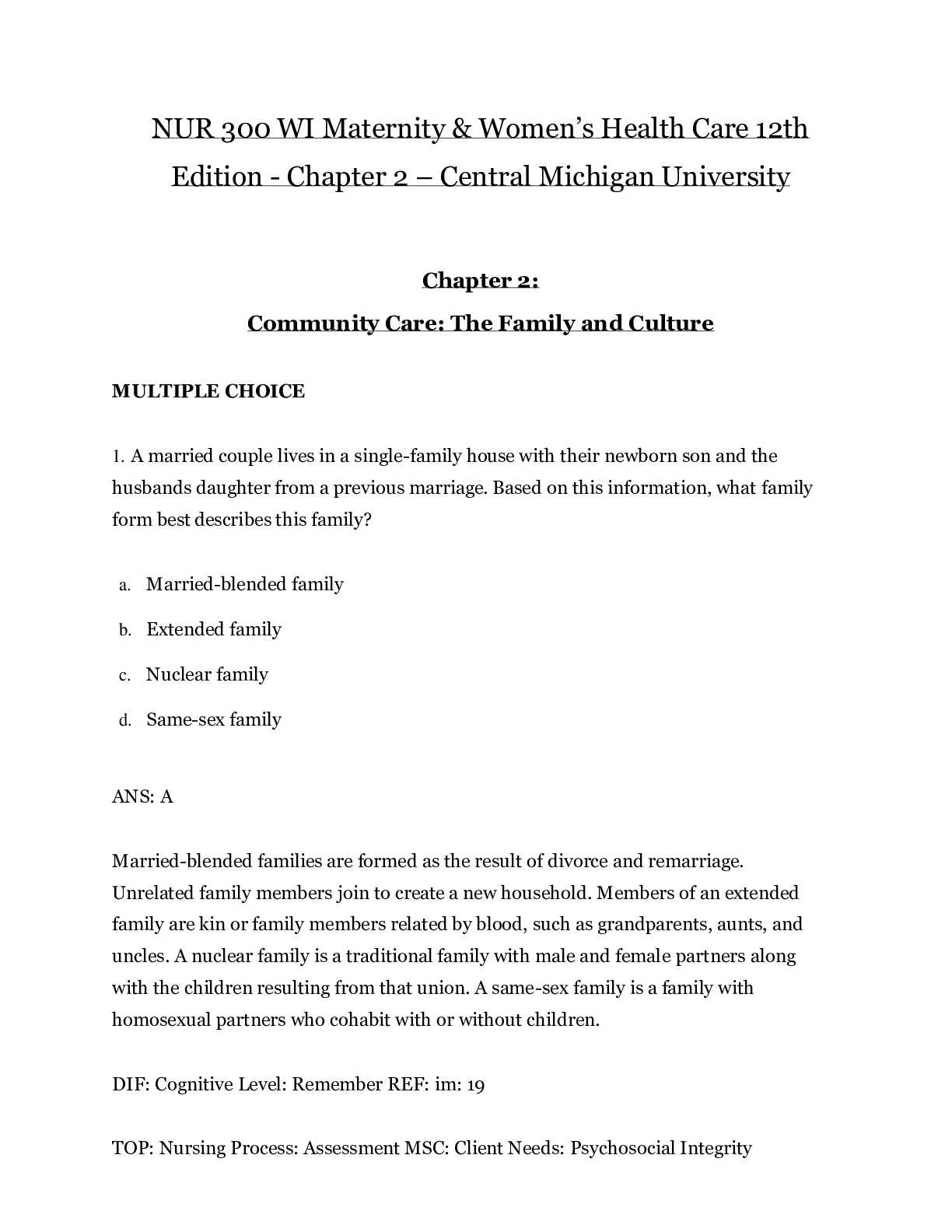*NURSING > EXAM > NUR 300 WI Maternity & Women’s Health Care 12th Edition (2019/2020) - Chapter 27 – Central Michi (All)
NUR 300 WI Maternity & Women’s Health Care 12th Edition (2019/2020) - Chapter 27 – Central Michigan University | Chapter 27: Hypertensive Disorders
Document Content and Description Below
NUR 300 WI Maternity & Women’s Health Care 12th Edition - Chapter 27 – Central Michigan University Chapter 27: Hypertensive Disorders MULTIPLE CHOICE 1. A primigravida is being monitored ... at the prenatal clinic for preeclampsia. Which finding is of greatest concern to the nurse? a. Blood pressure (BP) increase to 138/86 mm Hg b. Weight gain of 0.5 kg during the past 2 weeks c. Dipstick value of 3+ for protein in her urine d. Pitting pedal edema at the end of the day Proteinuria is defined as a concentration of 1+ or greater via dipstick measurement. A dipstick value of 3+ alerts the nurse that additional testing or assessment should be performed. A 24-hour urine collection is preferred over dipstick testing attributable to accuracy. Generally, hypertension is defined as a BP of 140/90 mm Hg or an increase in systolic pressure of 30 mm Hg or diastolic pressure of 15 mm Hg. Preeclampsia may be demonstrated as a rapid weight gain of more than 2 kg in 1 week. Edema occurs in many normal pregnancies, as well as in women with preeclampsia. Therefore, the presence of edema is no longer considered diagnostic of preeclampsia. DIF: Cognitive Level: Analyze REF: IM: 660 TOP: Nursing Process: Diagnosis MSC: Client Needs: Physiologic Integrity 2. The labor of a pregnant woman with preeclampsia is going to be induced. Before initiating the oxytocin (Pitocin) infusion, the nurse reviews the womans latest laboratory test findings, which reveal a platelet count of 90,000 mm3, an elevated aspartate aminotransaminase (AST) level, and a falling hematocrit. The laboratory results are indicative of which condition? a. Eclampsia b. Disseminated intravascular coagulation (DIC) syndrome c. Hemolysis, elevated liver enzyme levels, and low platelet levels (HELLP) syndrome d. Idiopathic thrombocytopenia HELLP syndrome is a laboratory diagnosis for a variant of severe preeclampsia that involves hepatic dysfunction characterized by hemolysis (H), elevated liver (EL) enzymes, and low platelets (LP). Eclampsia is determined by the presence of seizures. DIC is a potential complication associated with HELLP syndrome. Idiopathic thrombocytopenia is the presence of low platelets of unknown cause and is not associated with preeclampsia. DIF: Cognitive Level: Understand REF: IM: 657 TOP: Nursing Process: Diagnosis MSC: Client Needs: Physiologic Integrity 3. A woman with preeclampsia has a seizure. What is the nurses highest priority during a seizure? a. To insert an oral airway b. To suction the mouth to prevent aspiration c. To administer oxygen by mask d. To stay with the client and call for help If a client becomes eclamptic, then the nurse should stay with the client and call for help. Nursing actions during a convulsion are directed toward ensuring a patent airway and client safety. Insertion of an oral airway during seizure activity is no longer the standard of care. The nurse should attempt to keep the airway patent by turning the clients head to the side to prevent aspiration. Once the seizure has ended, it may be necessary to suction the clients mouth. Oxygen is administered after the convulsion has ended. DIF: Cognitive Level: Apply REF: IM: 666 TOP: Nursing Process: Implementation MSC: Client Needs: Physiologic Integrity 4. A pregnant woman has been receiving a magnesium sulfate infusion for treatment of severe preeclampsia for 24 hours. On assessment, the nurse finds the following vital signs: temperature 37.3 C, pulse rate 88 beats per minute, respiratory rate 10 breaths per minute, BP 148/90 mm Hg, absent deep tendon reflexes (DTRs), and no ankle clonus. The client complains, Im so thirsty and warm. What is the nurses immediate action? a. To call for an immediate magnesium sulfate level b. To administer oxygen c. To discontinue the magnesium sulfate infusion d. To prepare to administer hydralazine Regardless of the magnesium level, the client is displaying the clinical signs and symptoms of magnesium toxicity. The first action by the nurse should be to discontinue the infusion of magnesium sulfate. In addition, calcium gluconate, the antidote for magnesium, may be administered. Hydralazine is an antihypertensive drug commonly used to treat hypertension in severe preeclampsia. Typically, hydralazine is administered for a systolic BP higher than 160 mm Hg or a diastolic BP higher than 110 mm Hg. DIF: Cognitive Level: Apply REF: IM: 664 TOP: Nursing Process: Implementation MSC: Client Needs: Physiologic Integrity 5. A woman at 39 weeks of gestation with a history of preeclampsia is admitted to the labor and birth unit. She suddenly experiences increased contraction frequency of every 1 to 2 minutes, dark red vaginal bleeding, and a tense, painful abdomen. Which clinical change does the nurse anticipate? a. Eclamptic seizure b. Rupture of the uterus c. Placenta previa d. Abruptio placentae Uterine tenderness in the presence of increasing tone may be the earliest sign of abruptio placentae. Women with preeclampsia are at increased risk for an abruption attributable to decreased placental perfusion. Eclamptic seizures are evidenced by the presence of generalized tonic-clonic convulsions. Uterine rupture exhibits hypotonic uterine activity, signs of hypovolemia, and, in many cases, the absence of pain. Placenta previa exhibits bright red, painless vaginal bleeding. DIF: Cognitive Level: Understand REF: IM: 662 TOP: Nursing Process: Diagnosis MSC: Client Needs: Physiologic Integrity 6. A woman with worsening preeclampsia is admitted to the hospitals labor and birth unit. The physician explains the plan of care for severe preeclampsia, including the induction of labor, to the woman and her husband. Which statement by the husband leads the nurse to believe that the couple needs further information? a. I will help my wife use the breathing techniques that we learned in our childbirth classes. b. I will give my wife ice chips to eat during labor. c. Since we will be here for a while, I will call my mother so she can bring the two boys2 years and 4 years of ageto visit their mother. d. I will stay with my wife during her labor, just as we planned. Arranging a visit with their two children indicates that the husband does not understand the importance of the quiet, subdued environment that is needed to prevent his wifes condition from worsening. Implementing breathing techniques is indicative of adequate knowledge related to pain management during labor. Administering ice chips indicates an understanding of nutritional needs during labor. Staying with his wife during labor demonstrates the husbands support for his wife and is appropriate. DIF: Cognitive Level: Apply REF: IM: 662 TOP: Nursing Process: Evaluation MSC: Client Needs: Psychosocial Integrity 7. The client has been on magnesium sulfate for 20 hours for the treatment of preeclampsia. She just delivered a viable infant girl 30 minutes ago. What uterine findings does the nurse expect to observe or assess in this client? a. Absence of uterine bleeding in the postpartum period b. Fundus firm below the level of the umbilicus c. Scant lochia flow d. Boggy uterus with heavy lochia flow High serum levels of magnesium can cause a relaxation of smooth muscle such as the uterus. Because of this tocolytic effect, the client will most likely have a boggy uterus with increased amounts of bleeding. All women experience uterine bleeding in the postpartum period, especially those who have received magnesium therapy. Rather than scant lochial flow, however, this client will most likely have a heavy flow attributable to the relaxation of the uterine wall caused by magnesium administration. DIF: Cognitive Level: Analyze REF: IM: 664 TOP: Nursing Process: Assessment MSC: Client Needs: Physiologic Integrity 8. The client is being induced in response to worsening preeclampsia. She is also receiving magnesium sulfate. It appears that her labor has not become active, despite several hours of oxytocin administration. She asks the nurse, Why is this taking so long? What is the nurses most appropriate response? a. The magnesium is relaxing your uterus and competing with the oxytocin. It may increase the duration of your labor. b. I dont know why it is taking so long. c. The length of labor varies for different women. d. Your baby is just being stubborn. Because magnesium sulfate is a tocolytic agent, its use may increase the duration of labor. The amount of oxytocin needed to stimulate labor may be more than that needed for the woman who is not receiving magnesium sulfate. The nurse should explain to the client the effects of magnesium sulfate on the duration of labor. Although the length of labor varies for different women, the most likely reason this womans labor is protracted is the tocolytic effects of magnesium sulfate. The behavior of the fetus has no bearing on the length of labor. DIF: Cognitive Level: Apply REF: IM: 664 TOP: Nursing Process: Planning MSC: Client Needs: Health Promotion and Maintenance 9. What nursing diagnosis is the most appropriate for a woman experiencing severe preeclampsia? a. Risk for injury to mother and fetus, related to central nervous system (CNS) irritability b. Risk for altered gas exchange c. Risk for deficient fluid volume, related to increased sodium retention secondary to the administration of magnesium sulfate d. Risk for increased cardiac output, related to the use of antihypertensive drugs Risk for injury is the most appropriate nursing diagnosis for this client scenario. Gas exchange is more likely to become impaired, attributable to pulmonary edema. A risk for excess, not deficient, fluid volume, related to increased sodium retention, is increased, and a risk for decreased, not increased, cardiac output, related to the use of antihypertensive drugs, also is increased. DIF: Cognitive Level: Apply REF: IM: 660 TOP: Nursing Process: Diagnosis MSC: Client Needs: Physiologic Integrity 10. Which statement best describes chronic hypertension? a. Chronic hypertension is defined as hypertension that begins during pregnancy and lasts for the duration of the pregnancy. b. Chronic hypertension is considered severe when the systolic BP is higher than 140 mm Hg or the diastolic BP is higher than 90 mm Hg. c. Chronic hypertension is general hypertension plus proteinuria. d. Chronic hypertension can occur independently of or simultaneously with preeclampsia. Women with chronic hypertension may develop superimposed preeclampsia, which increases the morbidity for both the mother and the fetus. Chronic hypertension is present before pregnancy or diagnosed before the 20 weeks of gestation and persists longer than 6 weeks postpartum. Chronic hypertension becomes severe with a diastolic BP of 110 mm Hg or higher. Proteinuria is an excessive concentration of protein in the urine and is a complication of hypertension, not a defining characteristic. DIF: Cognitive Level: Understand REF: IM: 667 TOP: Nursing Process: Diagnosis | Nursing Process: Planning MSC: Client Needs: Physiologic Integrity - - - - - - - - - - - - - - - - - - - - - - - - - - - - - - - - - - - - - - - - - - - - - - - - - - - - - 20. Which statement most accurately describes the HELLP syndrome? a. Mild form of preeclampsia b. Diagnosed by a nurse alert to its symptoms c. Characterized by hemolysis, elevated liver enzymes, and low platelets d. Associated with preterm labor but not perinatal mortality The acronym HELLP stands for hemolysis (H), elevated liver (EL) enzymes, and low platelets (LP). The HELLP syndrome is a variant of severe preeclampsia and is difficult to identify because the symptoms are not often obvious. The HELLP syndrome must be diagnosed in the laboratory. Preterm labor is greatly increased; therefore, so is perinatal mortality. DIF: Cognitive Level: Understand REF: IM: 657 TOP: Nursing Process: Diagnosis | Nursing Process: Planning MSC: Client Needs: Physiologic Integrity [Show More]
Last updated: 2 years ago
Preview 1 out of 25 pages

Buy this document to get the full access instantly
Instant Download Access after purchase
Buy NowInstant download
We Accept:

Reviews( 0 )
$10.50
Can't find what you want? Try our AI powered Search
Document information
Connected school, study & course
About the document
Uploaded On
Jun 29, 2020
Number of pages
25
Written in
Additional information
This document has been written for:
Uploaded
Jun 29, 2020
Downloads
0
Views
81








 – University of the People.png)

















